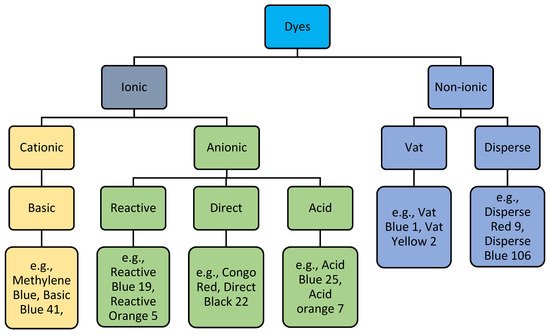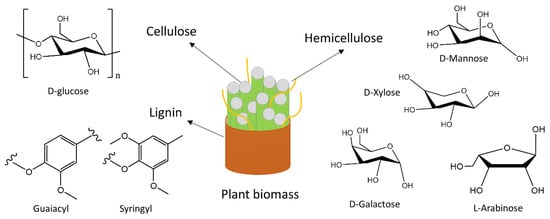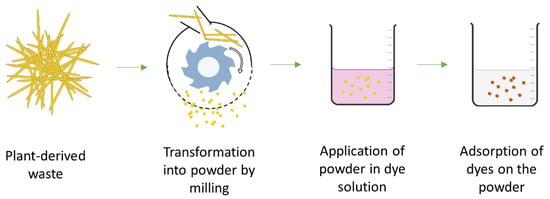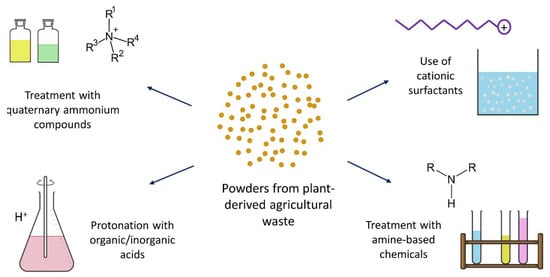Globally, the consumption of dyes is near seven hundred thousand tons across different sectors, of which around 10–15% goes into the wastewater. Among the dye kinds, anionic dyes make up the main proportion, having a 32–90% share in the wastewater. Different plant-derived wastes, which are sustainable given their natural abundance, effectiveness, and low cost, are frequently proposed for dye separation. However, these adsorbents are inherently more suitable for cationic dyes than anionic dyes. n recent years, the modification of these wastes has been progressively considered to suit them to anionic dye removal. These modifications involve mechanical, thermal, or chemical treatments, or combinations, which are the highlight of this study.
- lignocellulose
- natural biomass
- dye wastewater
1. Types of Anionic Dyes

1.1. Reactive Dye
1.2. Direct Dye
1.3. Acid Dye
2. Chemical Nature of Plant-Derived Agricultural Wastes

3. Adsorbents for Anionic Dyes
3.1. Mechanical Modifications

| Resources | Particle Size (µm) | Dye | qmax (mg/g) | Reference |
|---|---|---|---|---|
| Waste tea residue |
0.3475 | Acid Blue 25 | 127.14 | [15] |
| Date stones and jujube shells | 50–100 | Congo Red | 45.08–59.55 | [16] |
| Waste banana pith | >53 | Direct Red | 5.92 | [17] |
| Waste banana pith | >53 | Acid Brilliant Blue |
4.42 | [17] |
| Jujuba seeds | 53–150 | Congo Red | 55.56 | [18] |
| Cotton plant wastes | 75–500 | Remazol Black B |
35.7–50.9 | [19] |
| Lotus | <100 | Congo Red | 0.783–1.179 | [20] |
| Almond shell | 100–500 | Eriochrome Black T | 123.92 | [21] |
| Waste of corn silk | 250–500 | Reactive Blue 19 | 71.6 | [10] |
| Waste of corn silk | 250–500 | Reactive Red 218 | 63.3 | [10] |
| Banana peel, cucumber peel, and potato peel | 250–500 | Orange G | 20.9–40.5 | [14] |
| Eucalyptus bark | 250–700 | Solar Red BA | 43.5 | [22] |
| Eucalyptus bark | 250–700 | Solar Brittle Blue A | 49 | [22] |
| Saccharomyces cerevisiae (yeast) | 315–400 | Acid Red 14 | 18–23 | [23] |
| Mushroom waste | <400 | Direct Red 5B | 18 | [24] |
| Mushroom waste | <400 | Direct Black 22 | 15.46 | [24] |
| Mushroom waste | <400 | Direct Black 71 | 20.19 | [24] |
| Mushroom waste | <400 | Reactive Black 5 | 14.62 | [24] |
| Ash seed | ≤1000 | Cibacron Blue | 67.114 | [25] |
| Bean peel | ≤1000 | Cibacron Blue | 28.490 | [26] |
| Jute processing waste | 10,000 | Congo Red | 13.18 | [24][27] |
| Corn stigmata | Ground (size not mentioned) | Indigo Carmine | 63.7 | [24][28] |
| Cotton gin trash | Film form | Acid Blue 25 | 35.46 | [1] |
3.2. Chemical Modifications

3.3. Thermal Modifications

3.4. The Effect of Process Conditions
This entry is adapted from the peer-reviewed paper 10.3390/su141711098
References
- Haque, A.N.M.A.; Remadevi, R.; Wang, X.; Naebe, M. Adsorption of anionic Acid Blue 25 on chitosan-modified cotton gin trash film. Cellulose 2020, 27, 9437–9456.
- Broadbent, A.D. Basic Principles of Textile Coloration; Society of Dyers and Colorists Bradford: Bradford, UK, 2001; Volume 132.
- Khatri, A.; Peerzada, M.H.; Mohsin, M.; White, M. A review on developments in dyeing cotton fabrics with reactive dyes for reducing effluent pollution. J. Clean. Prod. 2015, 87, 50–57.
- Haque, A.N.M.A.; Islam, M.A. The contribution of different vinyl sulphone-reactive dyes to an effluent. J. Taibah Univ. Sci. 2015, 9, 594–600.
- Sekar, N. Acid dyes. In Handbook of Textile and Industrial Dyeing: Principles, Processes and Types of Dyes; Clark, M., Ed.; Woodhead Publishing Limited: Cambridge, UK, 2011; pp. 486–514.
- Chakraborty, J. Fundamentals and Practices in Colouration of Textiles; CRC Press: Boca Raton, FL, USA, 2015.
- Haque, A.N.M.A.; Zhang, Y.; Naebe, M. A review on lignocellulose/poly (vinyl alcohol) composites: Cleaner approaches for greener materials. Cellulose 2021, 28, 10741–10764.
- Haque, A.N.M.A.; Remadevi, R.; Naebe, M. Lemongrass (Cymbopogon): A review on its structure, properties, applications and recent developments. Cellulose 2018, 25, 5455–5477.
- Sanderson, K. Lignocellulose: A chewy problem. Nature 2011, 474, S12–S14.
- Değermenci, G.D.; Değermenci, N.; Ayvaoğlu, V.; Durmaz, E.; Çakır, D.; Akan, E. Adsorption of reactive dyes on lignocellulosic waste; characterization, equilibrium, kinetic and thermodynamic studies. J. Clean. Prod. 2019, 225, 1220–1229.
- Munagapati, V.S.; Kim, D.-S. Adsorption of anionic azo dye Congo Red from aqueous solution by Cationic Modified Orange Peel Powder. J. Mol. Liq. 2016, 220, 540–548.
- Aziz, E.K.; Abdelmajid, R.; Rachid, L.M.; Mohammadine, E.H. Adsorptive removal of anionic dye from aqueous solutions using powdered and calcined vegetables wastes as low-cost adsorbent. Arab. J. Basic Appl. Sci. 2018, 25, 93–102.
- Rodríguez, A.; García, J.; Ovejero, G.; Mestanza, M. Adsorption of anionic and cationic dyes on activated carbon from aqueous solutions: Equilibrium and kinetics. J. Hazard. Mater. 2009, 172, 1311–1320.
- Stavrinou, A.; Aggelopoulos, C.; Tsakiroglou, C. Exploring the adsorption mechanisms of cationic and anionic dyes onto agricultural waste peels of banana, cucumber and potato: Adsorption kinetics and equilibrium isotherms as a tool. J. Environ. Chem. Eng. 2018, 6, 6958–6970.
- Jain, S.N.; Tamboli, S.R.; Sutar, D.S.; Jadhav, S.R.; Marathe, J.V.; Shaikh, A.A.; Prajapati, A.A. Batch and continuous studies for adsorption of anionic dye onto waste tea residue: Kinetic, equilibrium, breakthrough and reusability studies. J. Clean. Prod. 2020, 252, 119778.
- El Messaoudi, N.; Dbik, A.; El Khomri, M.; Sabour, A.; Bentahar, S.; Lacherai, A. Date stones of Phoenix dactylifera and jujube shells of Ziziphus lotus as potential biosorbents for anionic dye removal. Int. J. Phytoremediat. 2017, 19, 1047–1052.
- Namasivayam, C.; Prabha, D.; Kumutha, M. Removal of direct red and acid brilliant blue by adsorption on to banana pith. Bioresour. Technol. 1998, 64, 77–79.
- Reddy, M.S.; Sivaramakrishna, L.; Reddy, A.V. The use of an agricultural waste material, Jujuba seeds for the removal of anionic dye (Congo red) from aqueous medium. J. Hazard. Mater. 2012, 203, 118–127.
- Tunç, Ö.; Tanacı, H.; Aksu, Z. Potential use of cotton plant wastes for the removal of Remazol Black B reactive dye. J. Hazard. Mater. 2009, 163, 187–198.
- Parimelazhagan, V.; Jeppu, G.; Rampal, N. Continuous Fixed-Bed Column Studies on Congo Red Dye Adsorption-Desorption Using Free and Immobilized Nelumbo nucifera Leaf Adsorbent. Polymers 2021, 14, 54.
- Ben Arfi, R.; Karoui, S.; Mougin, K.; Ghorbal, A. Adsorptive removal of cationic and anionic dyes from aqueous solution by utilizing almond shell as bioadsorbent. Euro-Mediterr. J. Environ. Integr. 2017, 2, 20.
- Tahir, M.A.; Bhatti, H.N.; Iqbal, M. Solar Red and Brittle Blue direct dyes adsorption onto Eucalyptus angophoroides bark: Equilibrium, kinetics and thermodynamic studies. J. Environ. Chem. Eng. 2016, 4, 2431–2439.
- Farah, J.Y.; Elgendy, N. Performance, kinetics and equilibrium in biosorption of anionic dye Acid Red 14 by the waste biomass of Saccharomyces cerevisiae as a low-cost biosorbent. Turk. J. Eng. Environ. Sci. 2013, 37, 146–161.
- Alhujaily, A.; Yu, H.; Zhang, X.; Ma, F. Adsorptive removal of anionic dyes from aqueous solutions using spent mushroom waste. Appl. Water Sci. 2020, 10, 183.
- Grabi, H.; Lemlikchi, W.; Derridj, F.; Lemlikchi, S.; Trari, M. Efficient native biosorbent derived from agricultural waste precursor for anionic dye adsorption in synthetic wastewater. Biomass Convers. Biorefinery 2021, 1–18.
- Grabi, H.; Derridj, F.; Lemlikchi, W.; Guénin, E. Studies of the potential of a native natural biosorbent for the elimination of an anionic textile dye Cibacron Blue in aqueous solution. Sci. Rep. 2021, 11, 9705.
- Banerjee, S.; Dastidar, M. Use of jute processing wastes for treatment of wastewater contaminated with dye and other organics. Bioresour. Technol. 2005, 96, 1919–1928.
- Mbarki, F.; Kesraoui, A.; Seffen, M.; Ayrault, P. Kinetic, thermodynamic, and adsorption behavior of cationic and anionic dyes onto corn stigmata: Nonlinear and stochastic analyses. Water Air Soil Pollut. 2018, 229, 95.
- Haque, A.N.M.A.; Remadevi, R.; Wang, X.; Naebe, M. Sorption properties of fabricated film from cotton gin trash. Mater. Today Proc. 2020, 31, S221–S226.
- Wong, S.; Ghafar, N.A.; Ngadi, N.; Razmi, F.A.; Inuwa, I.M.; Mat, R.; Amin, N.A.S. Effective removal of anionic textile dyes using adsorbent synthesized from coffee waste. Sci. Rep. 2020, 10, 2928.
- Jin, L.; Li, W.; Xu, Q.; Sun, Q. Amino-functionalized nanocrystalline cellulose as an adsorbent for anionic dyes. Cellulose 2015, 22, 2443–2456.
- Xu, X.; Gao, B.-Y.; Yue, Q.-Y.; Zhong, Q.-Q. Preparation and utilization of wheat straw bearing amine groups for the sorption of acid and reactive dyes from aqueous solutions. J. Hazard. Mater. 2010, 182, 1–9.
- Lyu, W.; Yu, M.; Feng, J.; Yan, W. Highly crystalline polyaniline nanofibers coating with low-cost biomass for easy separation and high efficient removal of anionic dye ARG from aqueous solution. Appl. Surf. Sci. 2018, 458, 413–424.
- Abdelghaffar, F. Biosorption of anionic dye using nanocomposite derived from chitosan and silver Nanoparticles synthesized via cellulosic banana peel bio-waste. Environ. Technol. Innov. 2021, 24, 101852.
- Soldatkina, L.; Zavrichko, M. Equilibrium, kinetic, and thermodynamic studies of anionic dyes adsorption on corn stalks modified by cetylpyridinium bromide. Colloids Interfaces 2018, 3, 4.
- Zhou, T.; Lu, W.; Liu, L.; Zhu, H.; Jiao, Y.; Zhang, S.; Han, R. Effective adsorption of light green anionic dye from solution by CPB modified peanut in column mode. J. Mol. Liq. 2015, 211, 909–914.
- Su, Y.; Zhao, B.; Xiao, W.; Han, R. Adsorption behavior of light green anionic dye using cationic surfactant-modified wheat straw in batch and column mode. Environ. Sci. Pollut. Res. 2013, 20, 5558–5568.
- Oei, B.C.; Ibrahim, S.; Wang, S.; Ang, H.M. Surfactant modified barley straw for removal of acid and reactive dyes from aqueous solution. Bioresour. Technol. 2009, 100, 4292–4295.
- Ibrahim, S.; Fatimah, I.; Ang, H.-M.; Wang, S. Adsorption of anionic dyes in aqueous solution using chemically modified barley straw. Water Sci. Technol. 2010, 62, 1177–1182.
- Ansari, R.; Seyghali, B.; Mohammad-Khah, A.; Zanjanchi, M.A. Highly efficient adsorption of anionic dyes from aqueous solutions using sawdust modified by cationic surfactant of cetyltrimethylammonium bromide. J. Surfactants Deterg. 2012, 15, 557–565.
- Namasivayam, C.; Sureshkumar, M. Anionic dye adsorption characteristics of surfactant-modified coir pith, a ‘waste’lignocellulosic polymer. J. Appl. Polym. Sci. 2006, 100, 1538–1546.
- Jiang, Z.; Hu, D. Molecular mechanism of anionic dyes adsorption on cationized rice husk cellulose from agricultural wastes. J. Mol. Liq. 2019, 276, 105–114.
- Koay, Y.S.; Ahamad, I.S.; Nourouzi, M.M.; Abdullah, L.C.; Choong, T.S.Y. Development of novel low-cost quaternized adsorbent from palm oil agriculture waste for reactive dye removal. BioResources 2014, 9, 66–85.
- Benabbas, K.; Zabat, N.; Hocini, I. Study of the chemical pretreatment of a nonconventional low-cost biosorbent (Callitriche obtusangula) for removing an anionic dye from aqueous solution. Euro-Mediterr. J. Environ. Integr. 2021, 6, 54.
- Doltabadi, M.; Alidadi, H.; Davoudi, M. Comparative study of cationic and anionic dye removal from aqueous solutions using sawdust-based adsorbent. Environ. Prog. Sustain. Energy 2016, 35, 1078–1090.
- Noreen, S.; Bhatti, H.N.; Nausheen, S.; Sadaf, S.; Ashfaq, M. Batch and fixed bed adsorption study for the removal of Drimarine Black CL-B dye from aqueous solution using a lignocellulosic waste: A cost affective adsorbent. Ind. Crops Prod. 2013, 50, 568–579.
- Won, S.W.; Kim, H.-J.; Choi, S.-H.; Chung, B.-W.; Kim, K.-J.; Yun, Y.-S. Performance, kinetics and equilibrium in biosorption of anionic dye Reactive Black 5 by the waste biomass of Corynebacterium glutamicum as a low-cost biosorbent. Chem. Eng. J. 2006, 121, 37–43.
- Saputra, O.A.; Nauqinida, M.; Pujiasih, S.; Kusumaningsih, T.; Pramono, E. Improvement of anionic and cationic dyes removal in aqueous solution by Indonesian agro-waste oil palm empty fruit bunches through silylation approach. Groundw. Sustain. Dev. 2021, 13, 100570.
- Lin, Q.; Wang, K.; Gao, M.; Bai, Y.; Chen, L.; Ma, H. Effectively removal of cationic and anionic dyes by pH-sensitive amphoteric adsorbent derived from agricultural waste-wheat straw. J. Taiwan Inst. Chem. Eng. 2017, 76, 65–72.
- Velinov, N.; Radović Vučić, M.; Petrović, M.; Najdanović, S.; Kostić, M.; Mitrović, J.; Bojić, A. The influence of various solvents’ polarity in the synthesis of wood biowaste sorbent: Evaluation of dye sorption. Biomass Convers. Biorefinery 2021, 1–12.
- Ahmaruzzaman, M.; Reza, R.A. Decontamination of cationic and anionic dyes in single and binary mode from aqueous phase by mesoporous pulp waste. Environ. Prog. Sustain. Energy 2015, 34, 724–735.
- Demiral, H.; Demiral, I.; Karabacakoğlu, B.; Tümsek, F. Adsorption of textile dye onto activated carbon prepared from industrial waste by ZnCl2 activation. J. Int. Environ. Appl. Sci. 2008, 3, 381–389.
- Bhomick, P.C.; Supong, A.; Baruah, M.; Pongener, C.; Sinha, D. Pine Cone biomass as an efficient precursor for the synthesis of activated biocarbon for adsorption of anionic dye from aqueous solution: Isotherm, kinetic, thermodynamic and regeneration studies. Sustain. Chem. Pharm. 2018, 10, 41–49.
- Ma, H.; Li, J.-B.; Liu, W.-W.; Miao, M.; Cheng, B.-J.; Zhu, S.-W. Novel synthesis of a versatile magnetic adsorbent derived from corncob for dye removal. Bioresour. Technol. 2015, 190, 13–20.
- Markets and Markets, Activated Carbon Market by Type, Application (Liquid Phase (Water Treatment, Foods & Beverages, Pharmaceutical & Medical), Gas Phase (Industrial, Automotive), and Region (APAC, North America, Europe, Middle East, South America)—Global Forecast to 2026. 2022. Available online: https://www.marketsandmarkets.com/Market-Reports/activated-carbon-362.html (accessed on 15 August 2022).
- Ao, W.; Fu, J.; Mao, X.; Kang, Q.; Ran, C.; Liu, Y.; Zhang, H.; Gao, Z.; Li, J.; Liu, G. Microwave assisted preparation of activated carbon from biomass: A review. Renew. Sustain. Energy Rev. 2018, 92, 958–979.
- Büchel, K.H.; Moretto, H.-H.; Werner, D. Industrial Inorganic Chemistry; John Wiley & Sons: Hoboken, NJ, USA, 2008.
- Bhatnagar, A.; Hogland, W.; Marques, M.; Sillanpää, M. An overview of the modification methods of activated carbon for its water treatment applications. Chem. Eng. J. 2013, 219, 499–511.
- Belyaeva, O.; Krasnova, T.; Semenova, S. Effect of modification of granulated activated carbons with ozone on their properties. Russ. J. Appl. Chem. 2011, 84, 597–601.
- Delamar, M.; Desarmot, G.; Fagebaume, O.; Hitmi, R.; Pinsonc, J.; Savéant, J.-M. Modification of carbon fiber surfaces by electrochemical reduction of aryl diazonium salts: Application to carbon epoxy composites. Carbon 1997, 35, 801–807.
- García, A.B.; Martínez-Alonso, A.; y Leon, C.A.L.; Tascón, J.M. Modification of the surface properties of an activated carbon by oxygen plasma treatment. Fuel 1998, 77, 613–624.
- Otake, Y.; Jenkins, R.G. Characterization of oxygen-containing surface complexes created on a microporous carbon by air and nitric acid treatment. Carbon 1993, 31, 109–121.
- Silva, A.R.; Freire, C.; De Castro, B.; Freitas, M.; Figueiredo, J. Anchoring of a nickel (II) Schiff base complex onto activated carbon mediated by cyanuric chloride. Microporous Mesoporous Mater. 2001, 46, 211–221.
- Theamwong, N.; Intarabumrung, W.; Sangon, S.; Aintharabunya, S.; Ngernyen, Y.; Hunt, A.J.; Supanchaiyamat, N. Activated carbons from waste Cassia bakeriana seed pods as high-performance adsorbents for toxic anionic dye and ciprofloxacin antibiotic remediation. Bioresour. Technol. 2021, 341, 125832.
- Nayak, A.; Bhushan, B.; Gupta, V.; Sharma, P. Chemically activated carbon from lignocellulosic wastes for heavy metal wastewater remediation: Effect of activation conditions. J. Colloid Interface Sci. 2017, 493, 228–240.
- Extross, A.; Waknis, A.; Tagad, C.; Gedam, V.; Pathak, P. Adsorption of congo red using carbon from leaves and stem of water hyacinth: Equilibrium, kinetics, thermodynamic studies. Int. J. Environ. Sci. Technol. 2022, 1–38.
- Zubair, M.; Mu’azu, N.D.; Jarrah, N.; Blaisi, N.I.; Aziz, H.A.; A Al-Harthi, M. Adsorption behavior and mechanism of methylene blue, crystal violet, eriochrome black T, and methyl orange dyes onto biochar-derived date palm fronds waste produced at different pyrolysis conditions. Water Air Soil Pollut. 2020, 231, 240.
- Mittal, A.; Mittal, J.; Malviya, A.; Gupta, V. Adsorptive removal of hazardous anionic dye “Congo red” from wastewater using waste materials and recovery by desorption. J. Colloid Interface Sci. 2009, 340, 16–26.
- Landin-Sandoval, V.; Mendoza-Castillo, D.; Seliem, M.; Mobarak, M.; Villanueva-Mejia, F.; Bonilla-Petriciolet, A.; Navarro-Santos, P.; Reynel-Ávila, H. Physicochemical analysis of multilayer adsorption mechanism of anionic dyes on lignocellulosic biomasses via statistical physics and density functional theory. J. Mol. Liq. 2021, 322, 114511.
- Demirbas, E.; Nas, M. Batch kinetic and equilibrium studies of adsorption of Reactive Blue 21 by fly ash and sepiolite. Desalination 2009, 243, 8–21.
